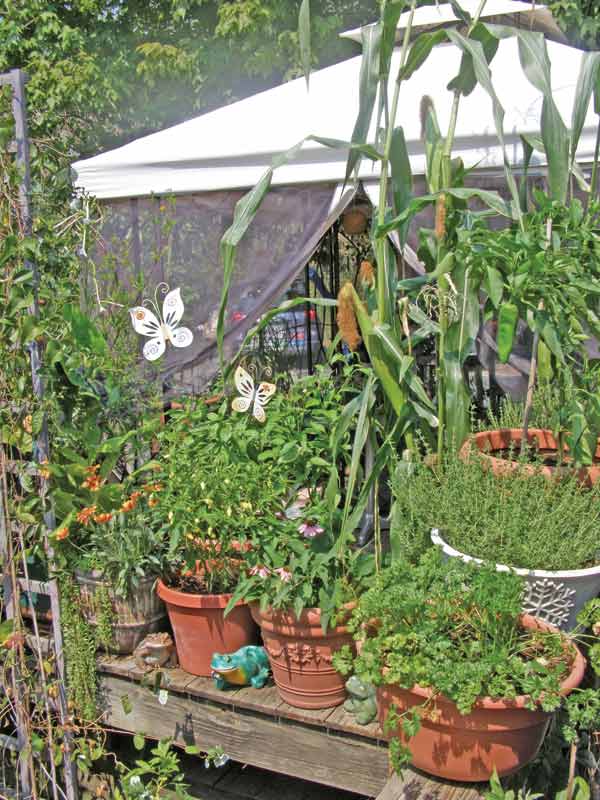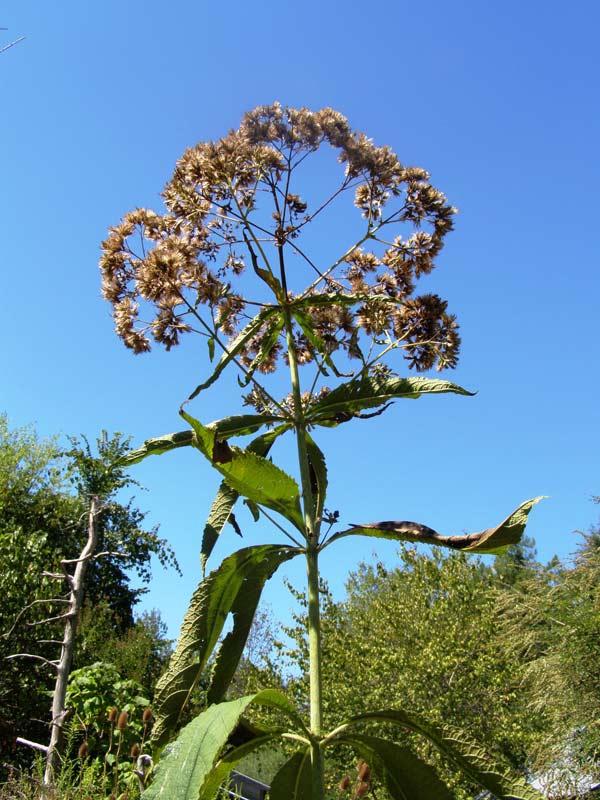Get creative with planting this fall

A variety of plants — from flowering annuals and perennials to kitchen herbs, tomatoes, peppers and even a few stalks of corn — are easily grown on a sunny deck or patio. Photo by Ken Moore
By Ken Moore
Flora Columnist
Fall is for planting, a time when one can get a spade into the soil and we have ample rainfall. Not this year. While we home gardeners lament our situation, let’s all pray to whatever spirits we honor for our local farmers who are hard pressed to begin those fall crops we so take for granted every September through December at our Carrboro Farmers’ Market.
Though it is not advisable to try a garden in the ground just now, we do have some options. Think containers, from expensive ceramic art pieces to the very useful discarded sheetrock buckets with holes in the bottom for drainage. It wasn’t the drought, but the local deer population that forced us to garden in containers on the deck several years ago. Though container gardening may require daily hand-watering, or at least daily checking for water needs, one becomes much more involved with the plants when caring for them up close and personal on a patio or deck, and water isn’t wasted. Here in our piedmont, a fall and winter garden is a much-too-often missed option for most of us. Don’t let the present heat and drought keep you from planting and harvesting a fall garden in containers.
There is no limit on what can be cultivated. I’ve enjoyed deck-grown okra in the past, and this year, just for fun, we have a few ears of corn for harvest. Search your local garden center and market for packets of seed for fall sowing. Your choice will include a great variety of root crops from beets, turnips, radishes and kohlrabi to leafy greens such as spinach and lettuces, even those giant collards, and the tasty edible flower head producing broccoli and cauliflower. Next time at the Farmers’ Market, be on the lookout for plant sets and seedlings of fall and winter veggies to set directly into your containers.
Remember to add slow-release organic fertilizers or composted manure to your soil mix and/or apply liquid fertilizers as needed from time to time. But if you have raccoons in your neighborhood, don’t use fish emulsion fertilizer. I did it earlier this season and the raccoons had a grand time digging up my container veggies trying to unearth that fishy smell.

Leave plant stems, such as Joe-Pye Weed, standing in your garden through the winter season to benefit birds and provide winter landscape interest. Photo by Ken Moore
The fall is also that time of year that many gardeners “put their garden to bed for the winter.†I never do, but I’m not one of those neat gardeners and I don’t have a disease and pest problem that many such gardeners use as justification for such tidiness. I don’t cut the dried upright stems of plants like goldenrods, asters and especially Joe-Pye Weeds. I leave them for the benefit of birds that use the branches for cover and perching as well as for seed and insect harvesting during the late months. And I love the winter interest. For example, an ice-covered seed head of Joe-Pye Weed is a real object of beauty in the winter landscape.
And here’s one more fall suggestion. If your perennials and biennials have green leaves at the base going into the winter months, make certain you do not cover those green basal rosettes with mulch. Many plants, such as Cardinal Flower, are lost by well-meaning gardeners covering green leaves with mulch.
Green foliage takes advantage of the winter sun.
Now, in spite of this drought, enjoy creating a container garden!
Email Ken Moore at flora@carrborocitizen.com.
Find all of Ken Moore’s Citizen columns at The Annotated Flora


Comments are closed.